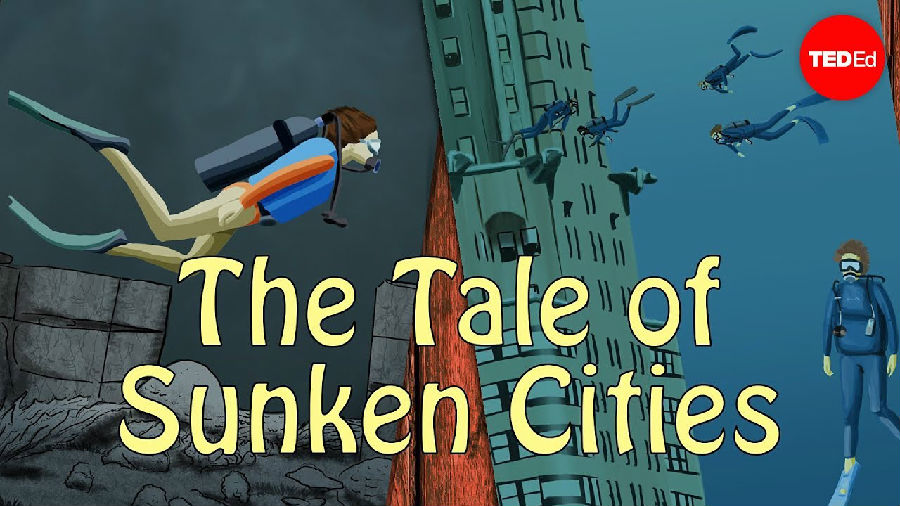(单词翻译:单击)
While touring the remains of ancient Alexandria, Egypt,
当你在埃及的亚历山大港遗迹游览时,
there are a few things that present-day explorers should look for.
有一些地方是今日的探险者们应寻觅的。
First, as you travel along the Great Harbor, keep your eyes open for large columns and statues.
首先,当你沿着大港湾旅行,留意那些大的柱子和雕像。
Across the bay to your left is the island where the Great Lighthouse once stood.
在你左手边的海湾那一边就是大灯塔曾经矗立过的岛屿。
And as you make your way through the palaces of the Royal Quarter
当你径直通过皇城的那些宫殿,
and reach the area where the Library of Alexandria once stood, keep your eyes open for sharks.
抵达亚历山大图书馆曾经矗立过的地区,你得睁大眼睛,小心鲨鱼!
Because if you visit this section of Alexandria, you'll be fifteen feet deep in the Mediterranean Sea.
因为假如你造访了亚历山大港的这个区域,你将置身于地中海15英尺深的水下。
Though people are most familiar with Plato's fictional Atlantis, many real underwater cities actually exist.
尽管人们多已熟知柏拉图虚构的亚特兰蒂斯,许多真实的水下城市确实存在。
Places like Alexandria, Port Royal, Jamaica, and Pavlopetri, Greece.
比如像亚历山大港、牙买加罗亚尔港和希腊帕夫洛佩特里这样的地方。
Sunken cities are studied by scientists to help us understand the lives of our ancestors,
科学家们研究沉没城市以帮助我们了解我们祖先的生活、
the dynamic nature of our planet, and the impact of each on the other.
地球的动态特性以及两者的相互影响。
Water is essential for life, food sources, and transport,
水对于生命、食物来源和交通来说至关重要,
so many cities have been built along coast lines and river banks.
因此许多城市沿着海岸和河岸建立。
However, these benefits also come with risks because natural forces that can sink a city are at their doorstep.
然而,这些好处也伴随着风险,因为能够使城市沉没的自然力量就在眼前。
Take, for instance, an earthquake.
以一场地震为例。
June 7, 1692 seemed like a normal morning in Port Royal, Jamaica, then one of the richest ports in the world,
1692年6月7日,对于当时世界上最富裕的港口之一的牙买加罗亚尔港来说似乎只是个平常的早晨,
but when a massive earthquake struck, two-thirds of Port Royal immediately sank to its rooftops.
但是当大地震袭来,罗亚尔港的三分之二立即下沉到只能看见屋顶。
Today, many buildings and elements of everyday life remain surprisingly intact on the sea floor, frozen in time.
现在,海底的许多建筑和日常生活的物品出人意料地保持完好,如同时间被冻结了一般。
That includes a 300-year-old pocket watch that stopped at 11:43, the moment Port Royal slipped beneath the Carribean.
这其中包括一只300年前的怀表,指针停在11点43分,罗亚尔港沉入加勒比海的那一刻。
And during the winter of 373 BCE, the Greek city of Helike was struck by an earthquake
公元前373年的冬天里,希腊城市赫里克遭受了一次地震袭击,
so strong that it liquefied the sandy ground upon which the city was built.
地震是如此强烈,以至于城市的沙质地基都液化了。
Minutes later, a tsunami struck the city, and Helike and its inhabitants sunk downwards into the Mediterranean Sea.
几分钟以后,海啸袭击了城市,于是赫里克及其居民一同沉没在地中海中。

Centuries later, Roman tourists would sail on the lagoon that formed and peer down at the city's remains.
几个世纪以后,罗马的游客们可以在形成的咸水湖上泛舟,朝水下俯视城市的遗迹。
Earthquakes are sudden, unpredictable disasters that have drowned cities in an instant.
地震是突发而不可预料的灾难,令城市在瞬间淹没。
Luckily, however, throughout history, the majority of sunken cities were not submerged by a single cataclysmic event,
但是幸运的是,纵观历史,大多数沉没城市并不是遭受一次单独的灾难事件而沉如水下,
but by a combination of more gradual processes.
而是一系列渐进过程的结果。
For instance, Pavlopetri, the oldest known sunken city, was built on the southern coastline of Greece 5,000 years ago.
比如帕夫洛佩特里,已知最古老的沉没城市,在5000年前建于希腊的南部海岸。
It's an example of a city that was submerged due to what is called isostatic sea level change.
它是由于被称为地壳均衡海平面变动的影响而沉入水中的城市的典型案例。
18,000 years ago when the Ice Age ended,
18000年以前,当冰河时期结束,
glaciers began melting and the sea level rose globally until about 5,000 years ago.
冰川开始融化,全球海平面上升直到5000年前。
Isostatic sea level change isn't caused by that melt water,
地壳均衡海平面变动并非由融化的海水导致,
but rather the Earth's crust slowly springing back from the released weight of the glaciers,
而是地球的地壳因为冰川释放的重量缓慢回弹,
making some places rise, and others sink.
使一些地方上升,另一些地方下沉。
The ground around Pavlopetri is still sinking at an average rate of a millimeter per year.
帕夫洛佩特里周围的地面仍在以平均每年1毫米的速度下沉。
But the ancient inhabitants were able to move gradually inland over several generations
但古代的居民们能够在许多代的时间里逐渐迁徙至内陆,
before they finally abandoned the city about 3,000 years ago.
直到在约3000年前最终废弃了这座城市。
Today, divers swim over the streets of Pavlopetri
现在,潜水者们在帕夫洛佩特里的街道上游泳,
and peer through ancient door jams into the foundations of houses and community buildings.
通过古代的门框往里观察房屋和社区建筑的地基。
They learn about the people who lived there by observing what they left behind.
他们通过观察遗留物了解曾生活在那里的人。
Natural geological events, such as earthquakes and tsunamis,
诸如地震和海啸这样的地质事件
will continue to shape our continents, just as they have for millions of years.
将持续塑造我们的大陆,正如百万年来一样。
As increased global warming melts our polar ice caps at accelerated rates and sea levels rise,
由于全球气温变暖导致极地冰盖加速融化,海平面上升,
we will be forced to adapt, like Pavlopetri's inhabitants.
我们可能会被迫适应,正如帕夫洛佩特里的居民一样。
Undoubtedly, over the coming centuries,
毫无疑问的是,在未来的几个世纪里,
some of the coastal areas that we live in today will eventually be claimed by the water, too
我们现在生活的一些沿海区域最终也将会被水淹没,
cities like Venice, New Orleans, Amsterdam, Miami, and Tokyo.
诸如威尼斯、新奥尔良、阿姆斯特丹、迈阿密和东京这样的城市。
Imagine what future civilizations will learn about us as they swim around the ancient ruins of the cities that we live in today.
想象一下,当未来文明的人们在我们现在生活城市的遗迹周围游泳时,他们会了解我们些什么呢?


